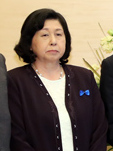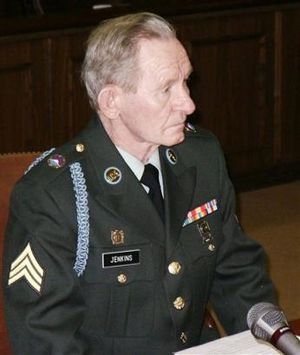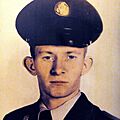Charles Robert Jenkins facts for kids
Quick facts for kids
Charles Robert Jenkins
|
|
|---|---|

SGT Jenkins in September 2004
|
|
| Born | 18 February 1940 Rich Square, NC, US
|
| Died | 11 Dec. 2017 (aged 77) Sado, Niigata, Japan
|
| Other names | "Super" |
| Citizenship |
|
| Occupation |
|
| Criminal charge(s) |
|
| Criminal penalty | 25 days imprisonment |
| Spouse(s) |
Hitomi Soga
(m. 1980) |
| Children | Two daughters |
| Military career | |
| Allegiance | United States |
| Branch |
|
| Rank | Private (from Sergeant) |
| Unit |
|
Charles Robert Jenkins (born February 18, 1940 – died December 11, 2017) was an American soldier who left his post and went into North Korea. He was held there for a long time. Later, he became a voice for Japanese people who had been kidnapped by North Korea.
In January 1965, Sergeant Jenkins was afraid of fighting in the Vietnam War. So, he left his patrol and walked across the border into North Korea. He hoped to go to the Soviet Union and then be sent back to the US. But instead, he was held captive in North Korea for over 39 years. While he was a prisoner, he was made to marry a Japanese woman who had also been captured. He also appeared in North Korean propaganda videos.
In 2004, Jenkins was allowed to travel to Japan. He left North Korea for good. He reported to the US Army in September that year. He faced a court-martial and spent 25 days in a military prison. Until he died in 2017, Jenkins lived in Japan with his wife and two daughters. He wrote a book about his time in North Korea and worked at a local museum. Many people in Japan treated him like a celebrity.
Contents
Early Life and Army Service
Charles Robert Jenkins was born on February 18, 1940, in Rich Square, North Carolina. He had two younger siblings. He left Rich Square High School when he was in the seventh grade. This happened after a sports injury or after his father passed away in the mid-1950s.
Because he didn't finish high school, Jenkins joined the North Carolina National Guard in 1955. He served there until 1958. After that, he joined the regular United States Army as an infantryman. He was first stationed at Fort Hood. Then, he volunteered to go to South Korea with the 7th Infantry Division from 1960 to 1961. While there, he was promoted to sergeant. After a short time back in the US, Jenkins was sent to West Germany. In 1964, he volunteered to go back to the Korean Demilitarized Zone (DMZ) for a second time.
Why Did He Leave His Post?
On January 5, 1965, Sergeant Jenkins was 24 years old. He was stationed at the DMZ. He decided to leave the US Army. He was being ordered to lead "more aggressive patrols." There were also rumors that his unit might be sent to Vietnam. Feeling scared, Jenkins went on patrol with his group. At 2:30 AM, he told the other three men that he "heard a noise." Then, he disappeared into the night. He was about ten kilometres (6.2 mi) south of Panmunjom.
To show he meant no harm, he took the bullets out of his rifle. He tied a white t-shirt to the end of it. He walked for several cold hours toward North Korea. He had planned to ask for safety in the Soviet Union. Then, he hoped to be sent back to the US for punishment. But instead, he was held prisoner in North Korea for 39 and a half years.
The Army first said Jenkins had left on purpose because of four letters he left behind. One letter to his mother said, "Forgive me, for I know what I must do." But his family disagreed, saying he always signed letters differently. In 1996, the US military officially called him a deserter.
Life in North Korea
When Jenkins first arrived in North Korea, he lived with three other American soldiers who had also left their posts: Larry Allen Abshier, James Joseph Dresnok, and Jerry Wayne Parrish. The American men sometimes argued. Jenkins later said that Dresnok, who was very tall, was a bully who would tell their captors what the others were doing.
On January 26, 1965, North Korean radio announced that Jenkins had come to their country. They said he was unhappy with conditions in South Korea and believed life was better in North Korea. In 1966, the four men tried to escape by seeking safety at the Soviet embassy in Pyongyang, but they failed. In 1972, the four US soldiers were given their own homes and declared citizens of North Korea. However, they were still watched all the time and treated poorly.
While held in North Korea, Jenkins had to learn the writings of Kim Il-sung, North Korea's leader. He also worked for the country as an English teacher and translator. Jenkins taught English until 1985. It was decided that his strong Southern accent was causing problems.
In 1978, Hitomi Soga was a young Japanese nurse. She and her mother were kidnapped by North Korean agents and taken to North Korea. There, they were forced to train other agents. The North Korean government told Soga, then 21, to marry Jenkins in 1980. They were married weeks later on August 8. They had two daughters, Mika (born 1983) and Brinda (born 1985). Jenkins later said that his wife, Soga, was the best thing that ever happened to him. He said she "saved my life." After they were released from North Korea, Jenkins offered to end their marriage since it had been forced. But Soga said no.
During a time when many North Koreans were starving, Jenkins and his family still received food, clothing, and soap because he was useful for propaganda. Jenkins and Soga later told the US Army about their living conditions. Heat, warm water, and food were hard to find. Their home was surrounded by barbed wire and hidden microphones. They were always watched by "political supervisors." By the time he left, Jenkins was getting a monthly income of US$120 (equivalent to $185.92 in 2022) from the North Korean government. His daughters were studying at a university in Pyongyang.
Acting in Propaganda Films
In 1978, North Korea began making a series of 20 films called Unsung Heroes. These films told the North Korean version of the Korean War. Jenkins was forced to play a character named Dr. Kelton. Dr. Kelton was a bad guy who wanted to make the war last longer to help the US weapons industry. These films made Jenkins famous in North Korea. People recognized him on the street as "Dr. Kelton!" and asked for his autograph. One of these films was sent to Jenkins' family in 1997. It was the first time they had seen him since he left his post.
Jenkins' last North Korean film was in 2000. It was about North Korea capturing a US Navy ship. In the film, he played a US aircraft carrier captain. Being a famous "defector-turned-movie-star" also gave him special treatment. He was allowed to meet Soviet officials and diplomats. They sometimes secretly gave him news and items from outside North Korea.
Leaving North Korea and Return to the US Military
In 2002, an agreement between Japan and North Korea allowed Soga to leave for Japan. She did not return to North Korea. The government of Japan asked the US to forgive Jenkins. They hoped Japanese Prime Minister Junichiro Koizumi could bring Jenkins and his daughters back to Japan. But Jenkins and his daughters refused to leave North Korea at first. Jenkins still faced a court-martial if he went to Japan. This was because the time limit for charging someone with desertion was 40 years, ending in January 2005. He also feared he might face the death penalty.
Eventually, North Korea allowed Jenkins to fly to Indonesia. There, he reunited with Soga. The Japanese government promised a place to live for the whole family. When he left North Korea, Jenkins was 1.65 metres (5 ft 5 in) tall and weighed only 100 pounds (45 kg). He had lost his appendix and part of a US Army tattoo. These were removed in North Korea without pain medicine. Of the four American soldiers who went to North Korea in the 1960s, he was the only one to ever leave. After arriving in Japan from Indonesia, Jenkins spent a month in a hospital. He was recovering from problems after prostate surgery he had in North Korea.
Facing the Court-Martial
| United States v. Jenkins | |
|---|---|

USARJ shoulder insignia
|
|
| Court | United States Army, Japan |
| Decided | 3 November 2004 |
| Court membership | |
| Judge(s) sitting | Colonel Denise Vowell |
On September 11, 2004, Jenkins reported to Lieutenant Colonel Paul Nigara at Camp Zama in Japan. He saluted and said, "Sir, I'm Sergeant Jenkins and I'm reporting." Jenkins' court-martial, which is a military trial, started and ended on November 3, 2004. He was the soldier who had been missing the longest to return to the US military.
Jenkins' trial lasted only one day. He pleaded guilty to leaving his post (desertion) and helping the enemy (for teaching English in North Korea). The judge sentenced him to "six months in prison, losing all pay, being reduced to the lowest rank, and a dishonorable discharge." However, a higher-ranking general changed the prison time to 30 days. Jenkins spent only 25 days in prison because he behaved well. He was released early on November 27, 2004. His demotion and dishonorable discharge became final in July 2005.
Some news reports suggested that Jenkins might have received a shorter sentence because of the information he gave to the US military. In 2009, Jenkins said that while he was in prison, he was also working with military intelligence. He said his sentence was "all a big set-up for the outside world so it looked like justice was done."
Life After Prison
After being released from prison, Jenkins lived with his family in his wife's childhood home in Sado, Japan. Even though he was free from North Korea, that country was still a part of his daily life. He worried that agents from North Korea might try to harm him in Japan. He also found it hard to eat certain foods because of his memories. He was more fluent in Korean than English. To share his story, Jenkins published a book in 2008 called The Reluctant Communist. In Japan, he became interested in motorcycling. He even appeared on the cover of a Japanese motorcycle magazine.
The Japanese government quickly approved Jenkins' request to live permanently in Japan. This happened on July 15, 2008. Jenkins worked in Sado selling senbei (rice crackers) at a local museum. He was treated like a celebrity and often posed for photos with Japanese visitors. He was given credit for helping to bring attention to the issue of Japanese citizens kidnapped by North Korea.
On December 11, 2017, Jenkins collapsed outside his home in Sado. He later died from heart disease.
See also
- Roy Chung
- Joseph T. White
Images for kids




